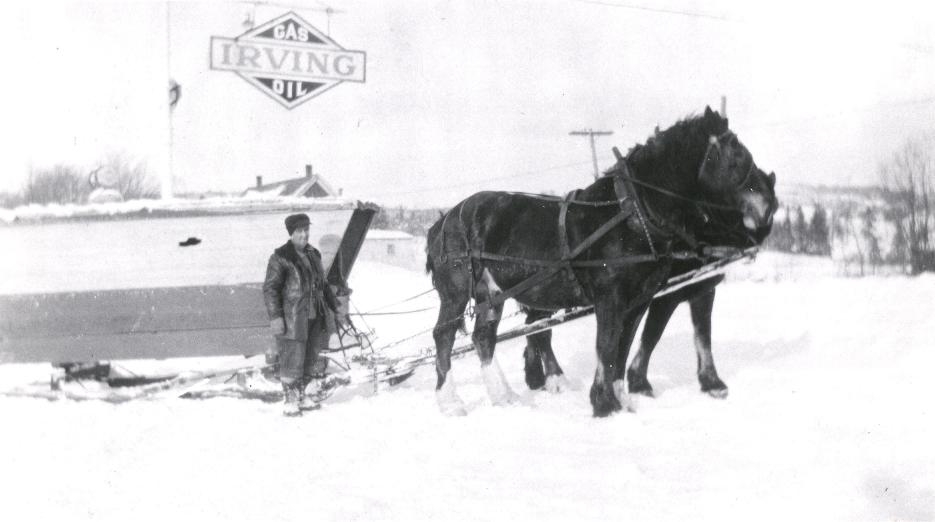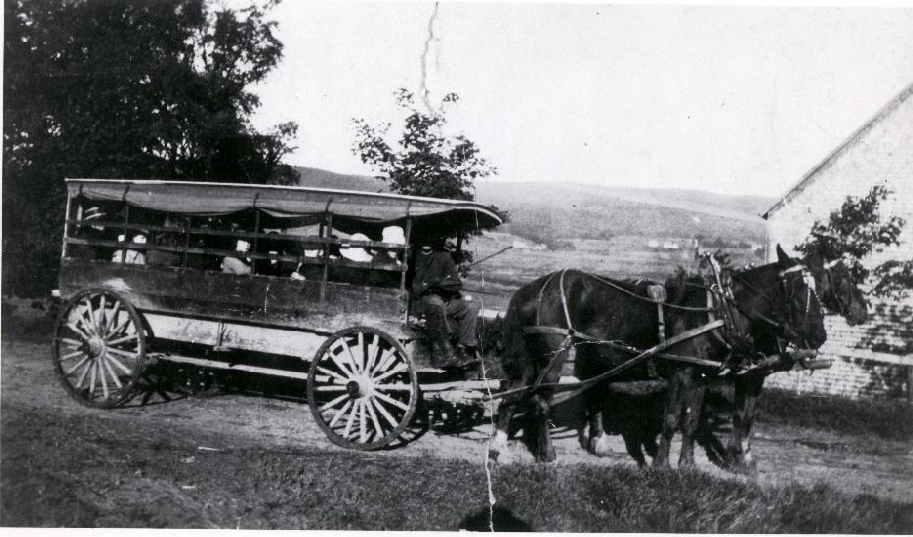When the Riverside Consolidated School was opened in 1905, it was considered to be one of the finest schools in the country.
The Riverside Consolidated School just prior to the completion of the school in 1905.
Riverside, Albert County, New Brunswick
With modern equipment like four furnaces, a plumbing and ventilation system, as well as courses not available in other schools, including domestic science courses, the school was considered modern by the standards of the day. The new school was quite a change from the one room schoolhouses which the students of the local area had attended in the past. Before the new school was built each small community in the area had its own small one room school. Due to the remoteness of some of these schools, students often had to walk several miles to get to school. During the winter months students often could not get to school because of poor weather conditions and even if they did arrive safely the teacher might not have been able to make it to the school. Another problem facing these smaller schools was that most did not have a janitor who would heat the school before the students arrived in the morning. In many cases the quality of education available at these smaller schools was sub-standard. The solution for this inequality between the education provided to students in municipalities and those students in more remote areas, was to build one large school, in a central location, and provide transportation to the school for the children who lived in the more remote areas.
The people who were in favour of consolidating the smaller one room schools into one large school argued that although the cost of educating students in the large school would be the same as educating them in the smaller schools, the students would receive a better quality education in the consolidated school. The students of the new school would have access to better educational facilities such as a library and a laboratory which were not available in the smaller schools. The students of the consolidated school would receive a better education because the teacher could concentrate on teaching a classroom full of students whowere at the same educational level instead of teaching children from many different grades in one classroom. In smaller schools the teachers either had to teach to several grade levels simultaneously or teach to one grade and then the next, so the students of each grade level did not receive as much instruction from the teacher as they would in the consolidated school. The new school would require fewer teachers and the financial savings from having fewer teachers could be used to hire better quality teachers. The school would allow the students of the area to have access to a higher level of education such as high school without having to send them away to private school or to attend high school in the city. Since it was dangerous for students to walk long distances through the snow in winter to get to school, the consolidated school offered transportation by van to the school in summer and winter which was less demanding physically and safer for the students. With modern heating and ventilation systems, plumbing, and a janitor to maintain the building and heat it during the winter months, the new school would provide a healthier environment for the students.
The people who were opposed to the new consolidated school objected to their children having to travel so far to attend school. Since the new school was to be built in a central location many more students would have to travel long distances to get to school. They also objected to their children being educated in another community. Many people objected to the idea that these new larger schools provided a better education as they felt that their children would receive a better education in the more traditional one room schoolhouse.
After some debate over whether the new school should be built in Riverside or Albert, a site midway between Riverside and Albert was finally chosen and construction of the Riverside Consolidated School began in July of 1904. Designed by local architect, W. E. Reid, construction of the new school was partially funded by a $5000 donation from Riverside resident and former Lieutenant-Governor of New Brunswick, Abner Reid McClelan, with the stipulation that manual training, household science, and nature work classes were to be provided, in addition to the more traditional subjects.
The consolidated school cost $20,000 to build and included eight class rooms, an office, two lunchrooms, a library, a laboratory, and two playrooms. The new school was staffed by seven teachers and a janitor. Students were brought by horse-drawn van from surrounding communities like Chester, Beaver Brook, Midway, Harvey, and Hopewell Hill during the spring and fall and by horse-drawn sleigh during the winter.
This photo taken in 1907 shows one of the first classes to attend the Riverside Consolidated School.
Two hundred and forty students were enrolled during that first school year.
The official opening of the school was attended by Premier Tweedie as well as many other dignitaries who were all quite impressed with the new facility, declaring it a model for other educational facilities across the Province.
Today after 100+ years of operation, the Riverside Consolidated School is the oldest operating consolidated school in Canada. Children from communities as far away as Lower Cape and Alma, attend the school from Kindergarten to grade five. Although the communities in the area now have smaller populations, the school still provides a quality education for the approximately 89 students who attend the school.






